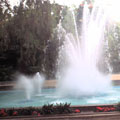Flora & Fauna.
 In its little more than 2 034 square kilometers in area, the island of Tenerife has a privileged ecological diversity due to its environmental conditions where numerous microclimates prevail. This favors the growth of a variety of plants, where nearly 1 400 higher plants form a complete harmony.
In its little more than 2 034 square kilometers in area, the island of Tenerife has a privileged ecological diversity due to its environmental conditions where numerous microclimates prevail. This favors the growth of a variety of plants, where nearly 1 400 higher plants form a complete harmony.
The territory is privileged to have some 140 unique species, the largest endemic flower collection in all Macaronesia. We should bear in mind that Macaronesia is one of the world’s most important natural regions for its wildlife.
Nearly half of the island’s environment is included in some of its 48 protected areas, including in the first place Teide National Park, which was created half a century ago. This place, having numerous attractions, has become in its own right the best well-attended site in Spain and has been proposed to be considered by UNESCO as a world heritage.
The largest variety of animal specimens, with over 6000 invertebrate species and 109 vertebrate species plus an exuberant flora can be seen at the Forest Crown Natural Park, where one can find the Canary pine tree as part of its vegetation.
Other attractions that will catch the visitor’s attention are the Anaga and Teno rural parks, as well as four wildlife reserves called Ljuana, Pirajal, Roques de Anaga and Pinorelis, lovely locations together with six special wildlife reserves, namely, Malpaís de La Rasca, Malpaís de Güímar, Montaña Roja (Red Mountain), Barranco del Infierno (Cliff of Hell), El Chinyero and Las Palomas (The Pigeons).
Tenerife has six well-defined ecosystems: Cardonal-Tabaibal (the typical endemic plants of this area are “tabaibas”, “cardones” (species of giant cactus) and “cardoncillos” (small cactus); Thermophilous forests (“sabinas”, dragon trees and palm trees); Laurisilva (forests of shrubs such as holly trees, vine trees and “barbuzanos”); Fayal-Brezal (“fayas”, heathers and holly trees); Pinewood (Canary pine-tree, “escobones” and cistus); High mountain (“tajinastes”, broom and Teide’s violet).
Among the endemic species of a varied flora, Teide’s violet has a privileged place, a unique plant to the volcano giving it its name; and laurisilva, a nearly wild forest formed by Lauraceae, from the Tertiary period, of which there are only a few samples left in the Macaronesia region.
Marine life is enriched with a wide diversity of over half a milliard species including groupers, tuna fish, morays, rays, barracudas, “vieiras”, “salemas”, codfish, “samas” and “cabrillas” , just to mention a few.
It should be noted that 19 species of cetaceans have been seen in the island’s seas, a habitat for the so-called pilot whales, also known as tropical “calderón”, and the place where they are most commonly found is in the straight separating the south coast of Tenerife from the neighboring island of La Gomera.